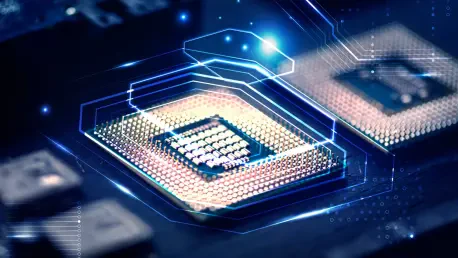Imagine a policy that promises to fund national coffers, curb a global rival’s technological rise, and protect domestic interests, all while stirring a storm of debate over its true cost. That’s precisely the scenario unfolding with the recent agreement between the Trump administration and semiconductor giants Nvidia and AMD. This deal, which mandates a 15 percent revenue payment on AI chip exports to China, has sparked heated discussions across economic, legal, and security spheres. This roundup dives into diverse perspectives from industry leaders, policy analysts, and economic experts to unpack whether this arrangement is a strategic masterstroke or a hidden burden on American innovation. The aim is to provide a comprehensive view of the implications and controversies surrounding this pivotal policy.
Diverse Voices on the Chip Deal Controversy
Economic Impacts: Revenue Gain or Competitive Loss?
Insights from industry analysts reveal a sharp divide on the economic ramifications of the 15 percent payment structure. Many argue that while the policy aims to generate significant revenue—potentially billions annually—for a ballooning federal deficit, it risks undermining the global competitiveness of US chipmakers. Higher costs for Nvidia’s ##0 and AMD’s MI301 chips in the Chinese market could drive customers toward alternatives, shrinking market share for American firms.
On the flip side, some fiscal policy experts see a silver lining in the potential funds this deal could inject into domestic manufacturing initiatives. They suggest that if reinvested wisely, the revenue might bolster US semiconductor production over the next few years, from 2025 onward. However, skepticism remains about whether the actual financial yield will match projections, given the likelihood of reduced sales volumes due to elevated prices.
A contrasting viewpoint emerges from trade economists who warn of unintended market distortions. They highlight historical patterns where export levies lead to evasion tactics like smuggling or rerouting through intermediaries. This perspective underscores a broader concern that the policy could inadvertently weaken the very industry it seeks to protect by pushing innovation and sales offshore.
Legal Gray Areas: Voluntary Payment or Coercive Tax?
Legal scholars and constitutional experts offer varied takes on the legitimacy of labeling this payment as anything other than an export tax. A significant faction contends that tying the 15 percent fee to export licenses strips away any notion of voluntariness, potentially violating constitutional bans on export taxes under Article I. They argue that the administration’s careful avoidance of the term “tax” appears more as a political maneuver than a legal defense.
Conversely, some policy advisors close to governmental circles maintain that framing the deal as a voluntary partnership sidesteps constitutional hurdles. They point out that companies like Nvidia and AMD ostensibly agreed to the terms, suggesting a novel approach to trade regulation rather than a traditional levy. Yet, this stance is met with raised eyebrows by those who see the export license requirement as a form of coercion rather than choice.
A third angle from independent legal analysts questions the precedent this sets for future trade policies. If unchallenged, such arrangements could normalize government-imposed fees under the guise of agreements, eroding clear boundaries between taxation and voluntary contribution. This debate continues to simmer as stakeholders await potential court challenges or legislative clarifications.
National Security: Safeguard or Strategic Misstep?
On the security front, defense and tech policy experts present a spectrum of concerns about allowing AI chip exports to China, even with a financial penalty. Many assert that reversing prior bans on these sales—initially enacted to prevent military advancements by a geopolitical rival—poses a direct risk. They fear that the revenue-driven compromise could accelerate China’s AI capabilities, narrowing the technological gap with the US.
A differing opinion comes from pragmatic security analysts who suggest that controlled exports with financial strings attached might offer a middle ground. They argue that complete bans often fuel black-market dealings, whereas regulated sales provide oversight and revenue simultaneously. However, this view struggles to address how funds generated justify potential long-term threats to national interests.
Another critical perspective focuses on global enforcement disparities. Some international security consultants note that inconsistent export control measures across regions could undermine the policy’s effectiveness, allowing China to source similar tech through less-regulated markets. This raises questions about whether a unilateral US policy can truly contain a global challenge without broader international alignment.
Government Role: Partnership or Overreach?
Industry leaders and economic commentators are split on the implications of the Trump administration’s direct involvement in business dealings through this deal. A segment of corporate voices expresses alarm over what they perceive as excessive meddling, citing risks of favoritism where politically connected firms might gain exemptions or advantages. They worry this could distort capital allocation and stifle free-market competition.
In contrast, some policy strategists defend the hands-on approach as a necessary evolution in strategic sectors like semiconductors. They argue that in an era of intense US-China tech rivalry, government partnerships with private entities are essential to align business incentives with national priorities. This view posits that selective interventions could steer innovation toward domestic goals over pure profit motives.
A more cautious stance from business ethics experts warns of the slippery slope toward systemic corruption. They highlight that personal negotiations over payment percentages or potential government stakes in firms like Intel could set a dangerous precedent. The concern is that such policies might prioritize short-term political wins over long-term economic stability, reshaping the relationship between state and industry in unpredictable ways.
Key Takeaways from the Debate
Reflecting on the myriad opinions surrounding the Nvidia-AMD deal, several core insights emerged over the course of this discussion. Economically, the policy’s promise of revenue was often overshadowed by fears of competitive decline and market evasion. Legally, the debate hinged on whether the payment structure breached constitutional limits, with no clear consensus on its validity. Security-wise, experts grappled with the paradox of funding national interests while potentially empowering a rival. Finally, the specter of government overreach loomed large, as stakeholders weighed the balance between strategic necessity and market freedom. For those eager to delve deeper, exploring trade policy journals and semiconductor industry reports from 2025 onward offers a wealth of additional context. Moving forward, policymakers might consider transparent frameworks for such deals, while businesses could advocate for balanced export controls that safeguard both innovation and security without stifling global reach.









